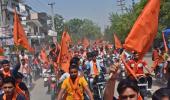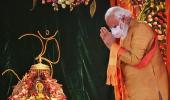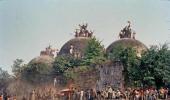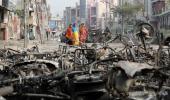Police escorted the rally all the way, at one point standing in a row to prevent the rallyists from entering a side road where stood a huge mosque.
Across the road, an old Muslim woman asked her Hindu neighbour what the rally was all about.
The latter shrugged her ignorance, looking on in bewilderment at the young men with their saffron flags, all of them wearing Bajrang Dal T-shirts.
Jyoti Punwani reports from Shourya Sanchalan, a Bajrang Dal rally in suburban Mumbai, to mark the 30th anniversary of the Babri Masjid demolition.

Who walks on a Sunday morning with the Bajrang Dal?
Those already part of the Sangh Parivar, it would seem.
Of the 200-odd men gathered in a municipal garden in Malad, a north western suburb of Mumbai, the majority had family connections with the RSS. "Be it the RSS, Bajrang Dal, Vishwa Hindu Parishad, we are all one family," explained one of the organisers.
Some of the older men present had been attending RSS shakhas since childhood; the younger ones had attended them off and on before getting involved in their studies or jobs. A few came because some elder in their housing colony had spread the word.
Among the youngest was a Class 9 student brought there by his chacha (father's brother). Would he continue to attend next year, once he joined the crucial Class 10? He looked unsure, but his chacha was sure he would.

This rally was the first event held by the Dindoshi (an area in Malad) unit of the Bajrang Dal. Called Shourya Sanchalan (bravery rally), it was held to mark the 30th anniversary of the Babri Masjid demolition, which the Sangh Parivar observes as Shaurya Diwas.
But a display of shaurya takes preparation, so for an hour, the men were trained how to march. "We have to create an impression for the public," the trainers told them.
Alas, the hard work went waste as the participants marched no differently from regular rallyists. That they hadn't been on a sports ground in years was obvious even during the training. As the trainers called out Sanskritised commands for "attention" and "right turn", some turned left, and others stood still.

"The rally is a shakti pradarshan (display of strength)," says Rajesh Gohil, one of the organisers. "It's meant to send the message to Hindus that the Bajrang Dal is here to protect you. These days Hindus are under attack, so they should know whom to turn to."
Part of the shakti pradarshan was a martial arts display wih lathis, conducted on the road near the Malad railway station, where the rally ended. Three women introduced as members of the Durga Vahini (the women's wing of the Bajrang Dal), displayed their skills with a lathi, as did a child.

Brothers Aadarsh and Aakash Shukla, both of whom had jobs, had joined the event because their sister was in the Durga Vahini. They had hoped to display their skills at sword fighting, but the police had not allowed that, they said regretfully.
After initial training in sword fighting by an RSS member, the two had trained themselves from You Tube videos. Regular training by the RSS in the use of lathis and swords was given in a municipal garden in the nearby suburb of Kandivli, they said.
Since it was a Sunday, there were only a few passersby as the rally wound its way through narrow lanes in predominantly Hindu areas, led by a jeep on which rode women from the Durga Vahini. About ten women formed the front row of the rally.
Not many residents came to their windows to look at the procession. However, outside one building, the rallyists were showered with flowers -- it turned out that many of them lived in that building.

Police escorted the rally all the way, at one point standing in a row to prevent the rallyists from entering a side road where stood a huge mosque. Across the road, an old Muslim woman asked her Hindu neighbour what the rally was all about. The latter shrugged her ignorance, looking on in bewilderment at the young men with their saffron flags, all of them wearing Bajrang Dal T-shirts on which were written 'kattar Hindu (strict Hindu)', and the old slogan 'garv se kaho hum Hindu hain (say with pride that we are Hindu)'.
The slogans shouted by the rally were mostly new. During the Babri Masjid Ram Janambhoomi movement, one of the commonest slogans was 'Is desh mein rehna hoga to Vande Matram kehna hoga'. On Sunday, the words 'Vande Matram' in this slogan were replaced by 'Jai Sri Ram'.
The other slogans were: 'Desh ki raksha kaun karega/Bajrang Dal, Nari ki raksha kaun karega/Bajrang Dal, Ghar ghar Bhagwa chhayega/Ram Rajya phir aayega, Dharmyudh ki karo tayyari/ aa rahein hain Bhagwadhari, Hum Bajrang Dal ke cheetey hain, apne dum se jeetey hain'.

***
The Bajrang Dal was formed during the Ayodhya movement in the 1980s, as the martial arm of the Vishwa Hindu Parishad. Recruitment rallies were held all over the country, where trishuls were distributed.
However, a speech introducing the organisation made at the end of Sunday's rally, portrayed the formation of the organisation as a spontaneous response to "Muslims opposing" the yatras that were taken out by the Vishwa Hindu Parishad during the Ayodhya movement.
It was interesting to see how, even after having achieved the goal of the Ayodhya movement, the Sangh Parivar continues to use the Babri Masjid as a rallying point.
A speech by a member of the VHP's Santa Cruz unit, also in suburban Mumbai, described in heavily exaggerated terms, the history of the Babri Masjid and its eventual demolition. On December 6, 1992, the VHP member claimed, even the sun delayed its setting to allow the mosque to be demolished before sunset. The crowd broke into shouts of "Jai Sri Ram."

Both the speeches that ended the rally were replete with derogatory references to Muslims and Christians as "Isa, Moosa", and words such as "jihadi". The bogey of 'love jihad' was repeatedly invoked; "thousands of Rohingyas and Bangladeshis" were coming into Mumbai everyday to lure Hindu girls and turn India into an Islamic nation, said the VHP member from Santacruz.

The introduction to the Bajrang Dal glorified the organisation's violent tendencies: "The Bajrang Dal are those who broke the Babri Masjid; who love not flowers but swords; who fight unafraid; they are the nemesis of jihadis; they hit 'love jihadis' on the roads; they teach a lesson to traitors."
"Can such speeches be allowed in a public place?" I asked the dozen-odd policemen standing there. "It's a democracy, anyone can say anything. But we are here to stop any trouble," replied one. Others smiled sheepishly or looked away.

A fourth of the participants had already left by the time the VHP member was halfway through his speech. A few youngsters left with their friends; some older ones got tired of sitting on the ground.
At the end, came the surprise announcement: "Now dance. Whoever wants can dance." As the music system blared out songs about Ram Mandir, the boys danced like they would at any wedding.
Feature Presentation: Aslam Hunani/Rediff.com










